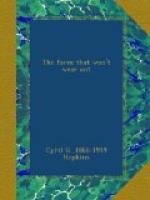Thus the combined gross earning power of both land and labor is less than $600 a year; while the brain work applied to the improvement of the soil on the same farm brings a net return of more than $950. Once in three years 50 pounds an acre of kainit was also applied. This would contain only 5 pounds of potassium, or less than would be required for one 7-bushel crop of corn.
These are the oldest experiments in the United States in which organic manures have been re-enforced with phosphorus, and the only addition suggested for the profitable improvement of this system is ground limestone on acid soils. These results only emphasize the fact that the average farm yields small returns upon the capital and labor invested, but the statement may well be repeated that the intelligent improvement of his soil, in systems of permanent agriculture, is the most profitable business in which the farmer and land owner can engage.
AUTHOR’S NOTE
The following generous statements are quoted here only because of the hope and earnest desire that those who have read the preceding pages may continue their study of the soil—the foundation of all agriculture—until they master the subject, and make their own the existing knowledge of the fundamental principles of permanent soil fertility.
“Another Great Sermon”
Have you read it? It is “The Story of the Soil,” by Doctor Cyril G. Hopkins, and not since the publication of Uncle Tom’s Cabin has any writer in the world produced a book of such tremendous importance to present and future generations. This sermon is in harmony with 20th century ideals. H. A. McKEENE, Secretary Illinois State Farmers Institute.
“The Story of the Soil:” from the basis of absolute science and real life. This is an odd book. It has a love story running through it, and it has an index, not a usual appendix to a novel. And yet it is not really a novel, but a scientific book on agriculture. There is just enough story to entice the less willing reader to absorb some of the latest results of soil analysis. The young man of the story visits Virginia and New England, with a view to purchasing a worn-out farm and building it up. He finally buys such a farm, and by the methods carefully explained restores it to fertility and profit. This requires dialogs and letters on scientific husbandry, even in the love-making, and one who reads and digests it will make a better farmer.—The Independent, New York.
“The Story of the Soil” has proven an inspiration to many of our California farmers. We wish for the book a widespread circulation. —California Cultivator.
I doubt if a dozen people in the country would believe that it is possible to write a novel about the soil—these big soil problems handled so ably, so plainly that any person can understand. Here is a book that certainly every man in the land should read.—Editor Charles W. Burkett, of American Agriculturist and of Ginn & Company’s Country Life Education Series.




